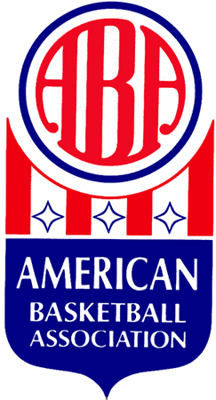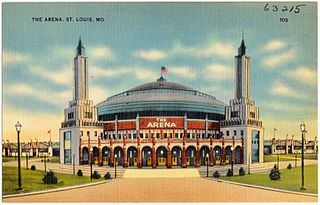
The American Basketball Association (ABA) was a popular men's professional basketball league from 1967 to 1976. The ABA merged into the National Basketball Association (NBA) in 1976, resulting in four ABA teams joining the NBA and the introduction of the NBA 3-point shot in 1979.

The San Diego Conquistadors, were an American Basketball Association (ABA) team based in San Diego. The "Q's", as they were popularly known, played from 1972 to 1975. As the Sails, they played an incomplete season only, beginning the 1975–1976 season but folding after only 11 games with 3 wins and 8 losses.

The Kentucky Colonels were a member of the American Basketball Association (ABA) for all of the league's nine years. The name is derived from the historic Kentucky Colonels. The Colonels won the most games and had the highest winning percentage of any franchise in the league's history, but the team did not join the National Basketball Association (NBA) in the 1976 ABA–NBA merger. The downtown Louisville Convention Center was the Colonels' venue for their first three seasons before moving to Freedom Hall for the remaining seasons, beginning with the 1970–71 schedule.

St. Louis Arena was an indoor arena in St. Louis, Missouri. The country's second-largest indoor entertainment venue when it opened in 1929, it was home to the St. Louis Blues and other sports franchises. The Arena sat across I-64 from Forest Park's Aviation Field.

The Carolina Cougars were a basketball franchise in the American Basketball Association that existed from 1969 through 1974. The Cougars were originally a charter member of the ABA as the Houston Mavericks in 1967. The Mavericks moved to North Carolina in late 1969 after two unsuccessful seasons in Houston at the Sam Houston Coliseum.

The Houston Mavericks were a charter member of the American Basketball Association (ABA). They played in the upstart league's first two seasons, from 1967 to 1969. Their home arena was the Sam Houston Coliseum. In 1947–48, there was an unrelated Mavericks franchise based in Houston as part of the Professional Basketball League of America.

Maurice Lucas was an American professional basketball player who played in the American Basketball Association (ABA) and the National Basketball Association (NBA). He was a four-time NBA All-Star and won an NBA championship with the Portland Trail Blazers in 1977. He was named to the ABA All-Time Team.
The 1976–77 NBA season was the 31st season of the National Basketball Association. The season ended with the Portland Trail Blazers winning their first NBA Championship in franchise history, beating the Philadelphia 76ers in six games in the NBA Finals.

Frederick L. Lewis is a retired American basketball player. He played professionally in the National Basketball Association (NBA) and American Basketball Association (ABA). He is the only player to start his career in the NBA, and play all 9 full ABA seasons (1967-1976) until the NBA/ABA merger, then sign back with the NBA.
Utah Rockies was the name under which the Spirits of St. Louis were to play during the ultimately aborted 1976–77 American Basketball Association (ABA) season.
The 1976–77 NBA season was the Spurs first season in the NBA. Months earlier, the Spurs were part of the American Basketball Association. The ABA had ended its ninth and last campaign. Of the seven remaining ABA teams, four joined the NBA: the Denver Nuggets, New York Nets, Indiana Pacers and San Antonio Spurs. The Kentucky Colonels and Spirits of St. Louis agreed to take a cash settlement and cease operations. Immediately, the ABA players were dispersed across the new 22-team league. The other ABA teams from the prior season were all folded prior to the ABA–NBA merger: the Baltimore Claws, Utah Stars, San Diego Sails and Virginia Squires.
The 1976–77 Denver Nuggets season, is the Nuggets first season in the NBA, after nine seasons in the ABA.
The 1975–76 Utah Stars season was the 6th and final season of the Utah Stars in the American Basketball Association. They folded due to financial pressures sixteen games into the regular season. As a result, the Stars were not part of the ABA–NBA merger that occurred at the conclusion of the season. Professional basketball would return to the Salt Lake City area when the New Orleans Jazz of the National Basketball Association relocated there following the 1978–79 season.

The ABA-NBA merger was a major pro sports business maneuver in 1976 when the American Basketball Association (ABA) combined with the National Basketball Association (NBA), after multiple attempts over several years. The NBA and ABA had entered merger talks as early as 1970, but an antitrust suit filed by the head of the NBA players union, Robertson v. National Basketball Ass'n, blocked the merger until 1976.
Ozzie and DanielSilna are American businessmen of Latvian descent best known for their success in the textile industry, as well as being co-owners of the American Basketball Association's Spirits of St. Louis and the lucrative deal cut to fold that team during the ABA-NBA merger.
The 1975–76 ABA season was the ninth and final season of the American Basketball Association. The shot clock was changed from 30 to 24 seconds to match the NBA. Dave DeBusschere was the league's new commissioner, its seventh and last. This was also the only season that did not use the East-West division setup. The NBA would adopt the ABA's three-point shot for the 1979–80 season.
The 1974–75 ABA season was the eighth season of the American Basketball Association. The Kentucky Colonels won the 1975 ABA Championship after winning the Eastern Division; the Denver Nuggets won the Western Division. Julius Erving and George McGinnis shared the league's MVP award.
The 1974-75 American Basketball Association season saw the Spirits of St. Louis, led by Marvin Barnes, Maurice Lucas, Gus Gerard and coach Bob MacKinnon, finish third in the ABA Eastern Division and defeat the New York Nets in the 1975 ABA Semifinals before losing in the Eastern Division Finals to the eventual ABA champion Kentucky Colonels.
The 1975-76 American Basketball Association season saw the Spirits of St. Louis, led by Marvin Barnes, Moses Malone, Ron Boone and Caldwell Jones, drop to sixth place in the ABA, with a record of 35-49. As a result, the Spirits missed the playoffs in their second and final season.
Donald Schupak is a New York business executive, investor, philanthropist, and attorney who is best known for his involvement with the Spirits of St. Louis during the 1976 ABA-NBA merger. The purchase of the Spirits by the NBA including Schupak's resulting ownership interest was called the best sports deal of the century by Sports Illustrated. He has served as chairman, chief executive officer, chief operating officer and strategy consultant for a number of public and private companies, including Horn & Hardart and IBM.









